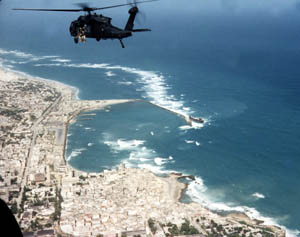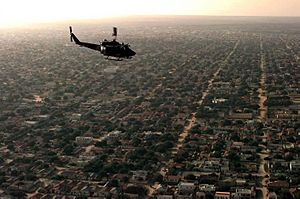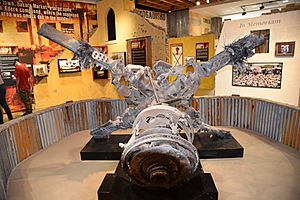Battle of Mogadishu (1993) facts for kids
Quick facts for kids Battle of Mogadishu |
|||||||
|---|---|---|---|---|---|---|---|
| Part of Operation Gothic Serpent | |||||||
 Super Six-Four, one of the Black Hawks which would be shot down, above Mogadishu |
|||||||
|
|||||||
| Belligerents | |||||||
Supported by: |
|||||||
| Commanders and leaders | |||||||
|
|||||||
| Strength | |||||||
| 160 initial forces 3,000 rescue forces 19 aircraft 16 helicopters 9 utility vehicles 3 trucks |
2,000–4,000 | ||||||
| Casualties and losses | |||||||
73 wounded 1 captured 2 helicopters destroyed 7 wounded 2 wounded |
|
||||||
The Battle of Mogadishu, also known as the Black Hawk Down incident, was a fierce fight in Mogadishu, Somalia. It happened on October 3–4, 1993. This battle was part of a bigger mission called Operation Gothic Serpent. Forces from the United States, with help from the United Nations (UNOSOM II), fought against the Somali National Alliance (SNA) and local citizens.
This battle took place during the Somali Civil War, which began in 1991. The United Nations first got involved to deliver food to people who were starving. But later, their goal changed to helping Somalia create a democracy and a new government.
A few months before the battle, on June 5, 1993, the UN faced a big loss. Pakistani peacekeepers were attacked while checking a weapons site. The UN blamed Mohamed Farrah Aidid, the leader of the SNA. He became a wanted person, and finding him was a main goal of the UN mission.
As part of the effort to capture Aidid, U.S. forces raided a place called Abdi House on July 12, 1993. Many important clan leaders died in this raid. This made many Somalis angry and caused them to support Aidid. Because of this, Aidid's forces started attacking American soldiers. This led President Clinton to send a special group called Task Force Ranger to capture Aidid.
On October 3, 1993, U.S. forces planned to capture two of Aidid's top helpers during a meeting in the city. The mission was supposed to be quick, lasting only an hour. But it turned into a long fight and rescue operation that lasted all night and into the next day. Even though the U.S. achieved its goal of capturing the targets, it came at a high cost.
During the mission, Somali forces shot down two American Sikorsky UH-60 Black Hawk helicopters using RPG-7 rockets. A desperate fight began to protect the soldiers who survived the crashes. The fighting continued through the night. In the morning, a UN armored convoy fought its way to the crash sites, saving the survivors but also suffering more injuries.
The battle resulted in 18 American soldiers killed and 73 wounded. One Malaysian soldier died, and seven were wounded. One Pakistani soldier died, and two were injured. Between 315 and 2,000 Somalis were killed or wounded. This battle greatly changed American foreign policy and led to the UN mission leaving Somalia in 1995.
After the battle, images of fallen American soldiers being treated disrespectfully by angry Somalis were shown on American TV. This caused a lot of public anger. The fear of another battle like this made the U.S. hesitant to get involved in other conflicts, like the Rwandan genocide. This feeling became known as "Somalia Syndrome."
Contents
Why the Battle Happened

In January 1991, Somalia's President, Mohamed Siad Barre, was overthrown by different groups. This started the Somali Civil War. The country's army broke apart, and many soldiers joined clan groups. In the capital city of Mogadishu, the main rebel group was the United Somali Congress (USC). This group later split into two parts. One was led by Ali Mahdi Muhammad, and the other by Mohamed Farrah Aidid. Aidid's group became known as the USC/SNA.
Later that year, heavy fighting broke out in Mogadishu and spread across the country. By the end of 1991, over 20,000 people had been hurt or killed. The conflict destroyed Somalia's farms, leading to widespread starvation.
The world community started sending food to help. But a lot of this food was stolen by local clan leaders. They often traded the food for weapons. It's thought that about 80 percent of the food aid was stolen. This made the starvation even worse. Between 1991 and 1992, about 300,000 people died from hunger, and 1.5 million more suffered.
To help, U.S. President George H. W. Bush started Operation Provide Relief in August 1992. U.S. military planes helped the UN deliver aid. Ten C-130 planes and 400 people went to Kenya. They flew aid to hard-to-reach areas in Somalia. In six months, these planes delivered 48,000 tons of food and medicine.
But this was not enough to stop the deaths and people leaving their homes. So, in December 1992, the U.S. launched a bigger mission called Operation Restore Hope. The goal was to protect humanitarian aid efforts. The U.S. Marines landed in Mogadishu. They quickly secured parts of the city, including the port and airport. This helped more aid get into the country.
Stories from the Battle
Many books and films have been made about the Battle of Mogadishu. They help us understand what happened.
Books About the Battle
- In 1999, Mark Bowden wrote Black Hawk Down: A Story of Modern War. This book tells the story of the battle.
- Michael Durant, a Black Hawk pilot who was shot down and captured, shared his story in his 2003 book In the Company of Heroes.
- Staff Sergeant Keni Thomas, a U.S. Army Ranger, wrote about his experience in Get It On!: What It Means to Lead the Way (2011).
- Howard E. Wasdin's book SEAL Team Six (2011) includes his experiences in Mogadishu.
- Lieutenant Colonel Michael Whetstone wrote Madness in Mogadishu (2013). This book tells about the rescue operation.
Films About the Battle
- Bowden's book was made into the film Black Hawk Down in 2001. It was produced by Jerry Bruckheimer and directed by Ridley Scott.
- An upcoming Malaysian film called Bakara will tell the story of the Malaysian soldiers who helped in the rescue.
Documentaries About the Battle
- The American TV series PBS Frontline aired a documentary called "Ambush in Mogadishu" in 1998.
- The True Story of Black Hawk Down (2003) was a TV documentary shown on The History Channel.
- The American Heroes Channel series Black Ops had an episode called "The Real Black Hawk Down" in June 2014.
- The National Geographic Channel series No Man Left Behind aired an episode called "The Real Black Hawk Down" on June 28, 2016.
- The Seconds from Disaster TV series featured the raid and rescue in an episode called "Chopper Down" in February 2018.
Remembering the Battle
Rangers Return to Mogadishu
In March 2013, two soldiers from Task Force Ranger went back to Mogadishu. They were with a film crew to make a short film called Return to Mogadishu: Remembering Black Hawk Down. This film came out in October 2013, on the 20th anniversary of the battle. Author Jeff Struecker and singer Keni Thomas drove through the Bakaara Market and visited the helicopter crash site.
Super 61 Returns to the U.S.
In August 2013, parts of Super 61, one of the Black Hawk helicopters shot down, were brought back to the United States. These parts, including the main rotor, are now on display at the Airborne & Special Operations Museum in Fort Bragg, North Carolina. The museum has exhibits with items from the battle, including parts of Super 61 and Super 64.
As of October 2018, a fully restored Super 68 helicopter is on display at the Army Aviation Museum in Fort Rucker, Alabama.
Images for kids
-
US Marines CH-53 Sea Stallion delivers aid to the village of Maleel (January 1993)
-
U.S. President Bill Clinton presenting the Medal of Honor to Carmen, the widow of Master Sergeant Gary I. Gordon, who served as Sniper Team Leader in the United States Army Special Operations Command with Task Force Ranger in Mogadishu.
-
Column of M1A1 Abrams and M2 Bradleys of 64th Armor Regiment in Mogadishu in January 1994
See also
 In Spanish: Batalla de Mogadiscio para niños
In Spanish: Batalla de Mogadiscio para niños











